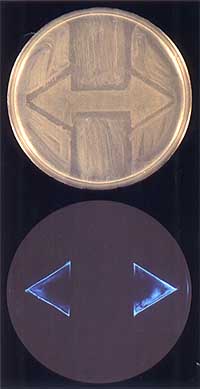News from
PRINCETON UNIVERSITY
Office of Communications
Stanhope Hall
Princeton, New Jersey 08544-5264
Telephone 609-258-3601; Fax 609-258-1301
Contact: Steven Schultz (609) 258-5729
Date: March 25, 1999
Study Reveals How Bacteria Communicate About Their Environment
"Quorum-sensing" gene could lead to new types of antibiotics
PRINCETON, N.J. -- A research project that started by asking esoteric questions about a glowing marine bacterium has begun to explain the workings of many other bacteria and could result in a new class of antibiotics.
|
|
|
|
In a petri dish, the arrow contains a mutant form of V. harveyi. On the left is a patch of E. coli that causes intestinal infections; on the right is Salmonella; in the middle, above and below the stem of the arrow, is a lab strain of E. coli that has lost its ability to harm people. In the dark (bottom photo), V. harveyi glows in the presence of the two pathogenic bacteria but not the harmless one. Above image: 687x1337
pixels |
The gene could become a valuable tool to drug developers looking for new ways to attack bacteria that are becoming increasingly resistant to current treatments. In some cases, bacteria only start emitting the toxins that cause disease after they multiply and develop into a dense population. Blocking the effects of the gene could make a bacterium act as though it were back in the puddle.
Bassler found this molecular signal after years of studying certain luminescent bacteria that are widespread in oceans but are harmless to people. Her work focuses on figuring out how and why two species, called Vibrio harveyi and Vibrio fischeri, emit a blue glow.
Bassler and other scientists found years ago that these glowing bacteria are capable of perceiving when they are in a dense population, a phenomenon called "quorum sensing." Each bacterium emits a small signaling chemical that builds in concentration as a population grows. When there is enough chemical, the bacteria adjust to their crowded environment. For V. fischeri and V. harveyi, the response is to emit a blue glow.
In fact, V. harveyi has two quorum-sensing systems, either of which can trigger the glowing. Puzzled about why there would be seemingly redundant systems, Bassler constructed mutant V. harveyi strains that respond to only one signal or the other. She used these mutants to show that one system tells the bacteria how many of its own species are in the area; the other tells how many other types of bacteria are around. That alone was an interesting discovery because it suggested that there is interspecies communication among bacteria. "Vibrio harveyi is out there talking away to these other bacteria," Bassler said.
Perhaps more interesting is the possibility that other bacteria are talking too. In the February 16 issue of the Proceedings of the National Academy of Sciences, Bassler reported that other bacteria produce the chemical that triggers quorum sensing in V. harveyi. She and her collaborators used specially engineered strains of V. harveyi, Salmonella, E. coli, and V. cholerae to show that the gene responsible for signal production was identical in every case. They named the gene LuxS. The discovery of LuxS opened up a whole new avenue of research because scientists can now use it to test in more detail how bacteria use quorum sensing.
One way bacteria may use LuxS could be in controlling their own behavior during infection. For example, Bassler's studies in E. coli and Salmonella suggest that these bacteria may wait until they reach a critical cell number before they produce the virulence factors that cause symptoms of infection. LuxS could be the key to this ability. If bacteria started producing toxins as soon as the infection began, "It would be like waving a flag to alert the host's immune system," Bassler said. "If the bacteria are in small numbers, they don't stand a chance, but if they wait until they reach high cell densities, then they have a much better chance of establishing a productive infection."
The expansion of Bassler's work to other bacteria was an astounding step, both to her and other scientists. "Vibrio harveyi bioluminescence is an incredibly arcane discipline, with no application at all. Then all of a sudden this happens, with all kinds of applications for important pathogens," said Stephen Winans, associate professor of microbiology at Cornell University. "I think that's extremely exciting."
When she came to Princeton four years ago, Bassler herself would have never guessed she would be working with E. coli and Salmonella. She received her PhD from Johns Hopkins University, where she studied various marine bacteria in the Vibrio genus, then went to the Agouron Institute in La Jolla, CA and focused solely on the two luminescent species. When she made her early discoveries about quorum sensing, "Everyone thought, 'Well, that's cute...'" Bassler said.
Now many researchers, including those working for pharmaceutical companies, are asking to use her specially engineered bacteria, called reporter strains. During an interview, her computer beeped repeatedly to announce the arrival of e-mail requests. Through the university, she has taken out a patent.
The new direction in her work shows how it's important for scientists to pursue questions just because they are interesting, even if they don't have an obvious practical application. "I have always believed that my group could uncover fundamental biological design principles about how bacteria communicate with one another and adapt to a changing environment using luminescence in V. harveyi. It is a great model system for such studies," Bassler said. This new work, showing that pathogens use mechanisms analogous to V. harveyi, underscores the importance of basic, open-ended research."
Bassler's latest paper in the Proceedings of the National Academy of Sciences is available at http://www.pnas.org/cgi/content/abstract/96/4/1639.
